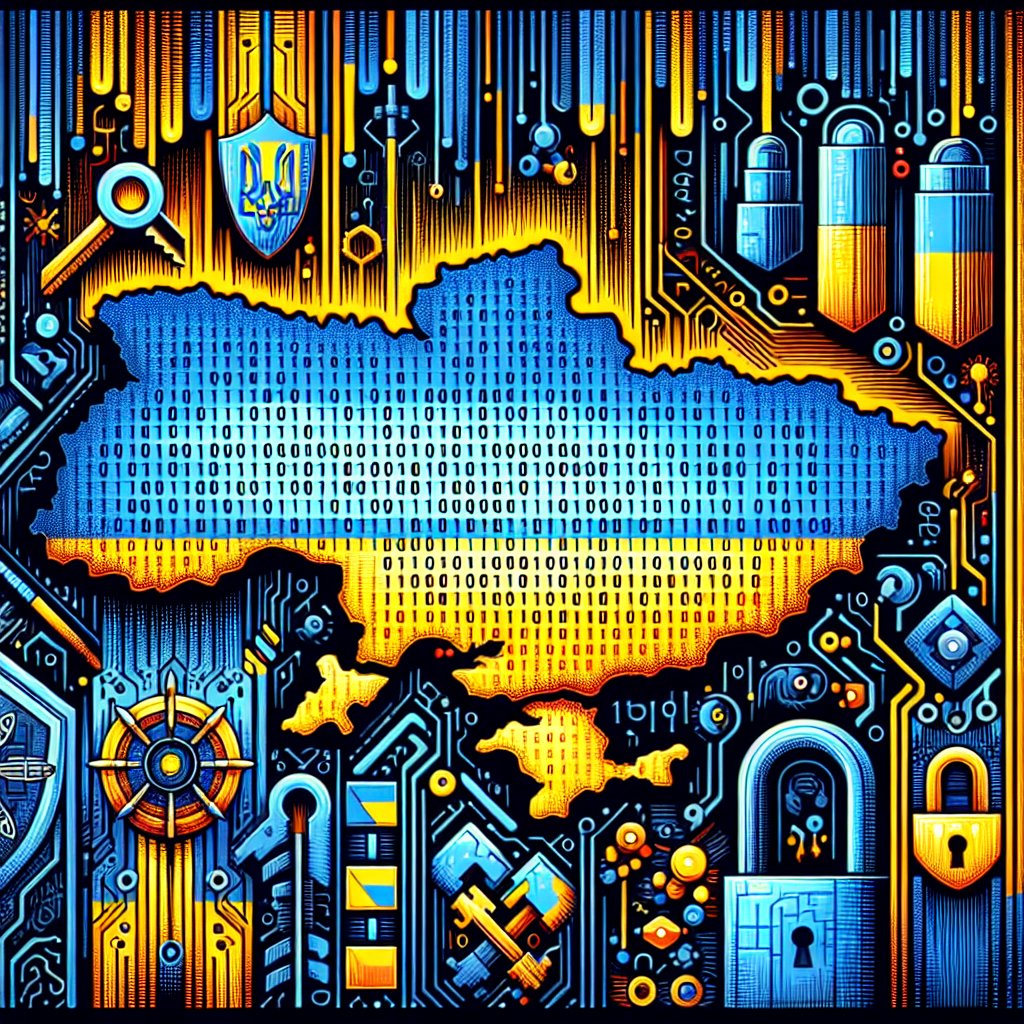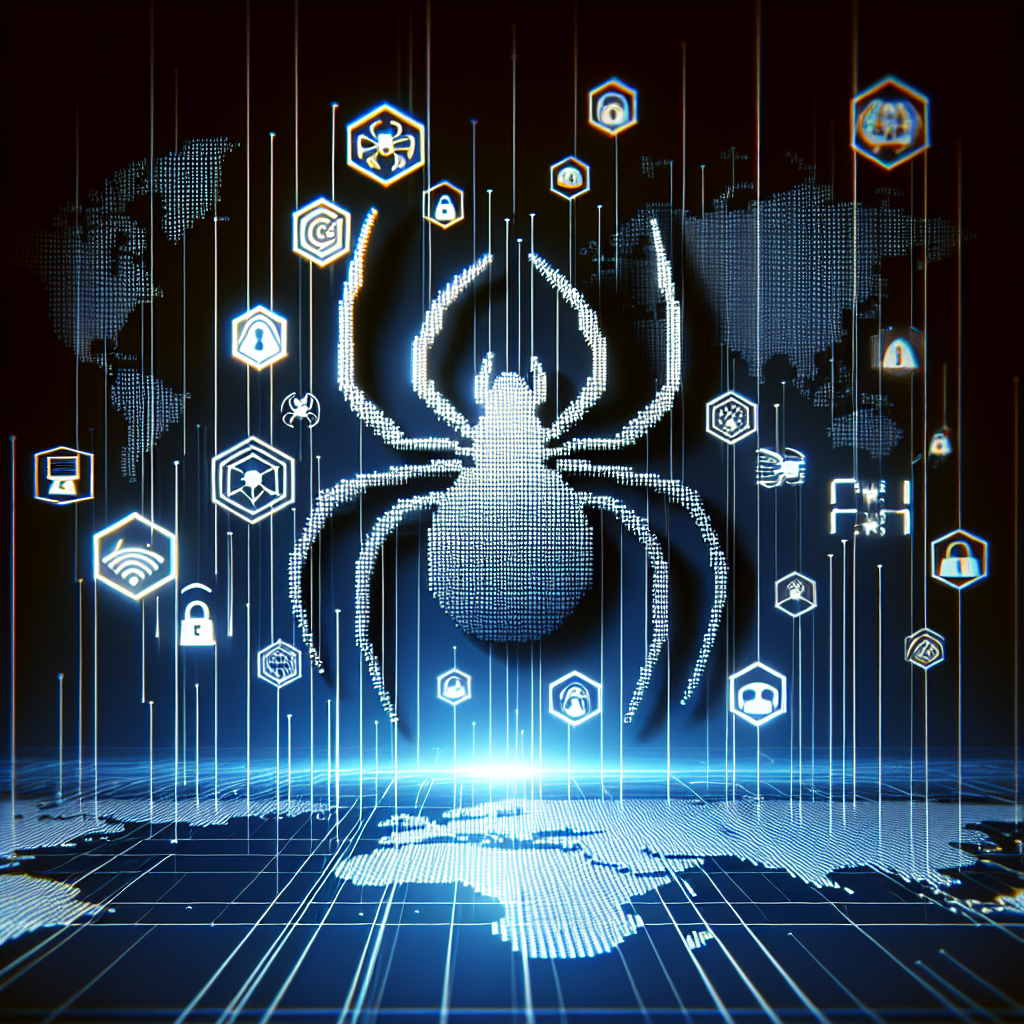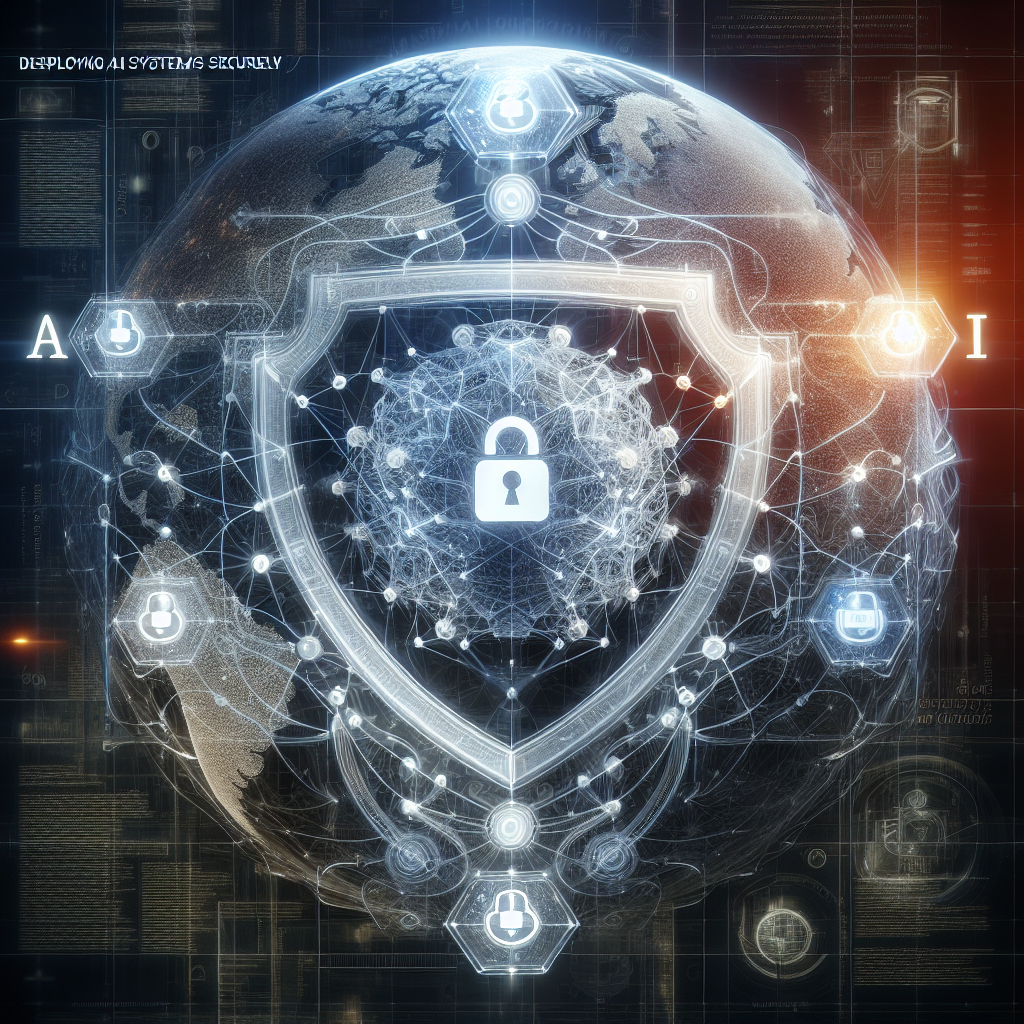The Silent Battlefield: How Ukraine Fights Back in the Cyber War
In recent years, Ukraine has become a battleground for a different kind of warfare – cyber warfare. As tensions between Ukraine and Russia continue to simmer, both sides have increasingly turned to digital weapons to gain the upper hand. This ongoing battle in cyberspace has had far-reaching consequences, not only for the two nations involved but also for the global community.
This article delves into the world of cyber warfare in Ukraine, exploring the tactics, strategies, and implications of this new form of conflict. From the infamous NotPetya ransomware attack to the disruption of critical infrastructure, we will examine how cyber attacks have been used as a weapon of choice in this ongoing conflict. Furthermore, we will explore the role of state-sponsored hacking groups, the motivations behind their actions, and the potential for escalation in this digital battleground. As the world becomes increasingly interconnected, understanding the dynamics of cyber warfare in Ukraine is crucial for policymakers, security experts, and the general public alike.
Key Takeaways:
1. Ukraine has been a major battleground for cyber warfare, with both state-sponsored and independent actors targeting critical infrastructure and government systems.
2. The 2015 cyber attack on Ukraine’s power grid was a wake-up call for the world, highlighting the vulnerability of critical infrastructure to cyber threats.
3. Russia has been identified as a primary aggressor in cyber warfare against Ukraine, using tactics such as distributed denial of service (DDoS) attacks and malware campaigns.
4. The Ukrainian government has made significant efforts to strengthen its cyber defenses, but faces challenges due to limited resources and the evolving nature of cyber threats.
5. International cooperation and support are crucial in combating cyber warfare, as the threat extends beyond national borders and requires a collective response.
The Rise of State-Sponsored Cyber Attacks
In recent years, Ukraine has become a battleground for state-sponsored cyber attacks. As tensions between Ukraine and Russia continue to escalate, cyber warfare has emerged as a powerful tool in the ongoing conflict. This trend has significant implications not only for Ukraine but also for the global cybersecurity landscape.
State-sponsored cyber attacks involve the use of advanced hacking techniques by governments to infiltrate and disrupt the computer networks of their adversaries. These attacks can target various sectors, including government institutions, critical infrastructure, and military networks. Ukraine has been a prime target for such attacks due to its geopolitical position and ongoing conflict with Russia.
One notable example of state-sponsored cyber warfare in Ukraine is the NotPetya ransomware attack in 2017. This attack, widely believed to be orchestrated by Russia, caused widespread damage to Ukrainian infrastructure and had collateral effects on global organizations. It highlighted the potential for cyber attacks to have far-reaching consequences beyond their intended targets.
The rise of state-sponsored cyber attacks in Ukraine has raised concerns about the future of warfare. Traditional military strategies are increasingly being complemented by cyber capabilities, blurring the lines between physical and virtual battlegrounds. The use of cyber attacks allows states to exert influence and cause disruption without resorting to conventional military force.
As this trend continues to evolve, it is crucial for governments and cybersecurity professionals to develop robust defenses against state-sponsored cyber attacks. International cooperation and information sharing are essential to counter this emerging threat and mitigate its potential impact.
The Weaponization of Information
In addition to cyber attacks, Ukraine has also been a testing ground for the weaponization of information. Disinformation campaigns and propaganda have become powerful tools used by both state and non-state actors to shape public opinion and influence political outcomes.
The conflict in Ukraine has seen the proliferation of fake news, misinformation, and propaganda spread through social media platforms and online news outlets. These campaigns aim to manipulate public perception, sow discord, and undermine trust in democratic institutions. They often exploit existing divisions within society, exacerbating tensions and further polarizing communities.
The weaponization of information has far-reaching implications for the future of warfare and democracy. It blurs the line between truth and falsehood, making it increasingly challenging for individuals to discern reliable information from misinformation. This erosion of trust in traditional sources of information undermines the foundations of democratic societies.
Ukraine’s experience with information warfare serves as a cautionary tale for other nations. It highlights the need for robust mechanisms to counter disinformation and protect the integrity of democratic processes. Governments, tech companies, and civil society must work together to develop strategies that promote media literacy, fact-checking, and critical thinking skills.
The Emergence of Cyber Mercenaries
Another emerging trend in the ongoing cyber warfare in Ukraine is the rise of cyber mercenaries. These are individuals or groups who offer their hacking skills and services to the highest bidder. They operate outside traditional state structures and are motivated by financial gain rather than political or ideological motives.
Cyber mercenaries have played a significant role in the conflict between Ukraine and Russia. They have been involved in various cyber attacks, including the targeting of government institutions, critical infrastructure, and military networks. The use of cyber mercenaries allows state actors to distance themselves from the attacks, making attribution more challenging.
The emergence of cyber mercenaries raises concerns about the privatization of cyber warfare and the potential for unregulated cyber attacks. Unlike state-sponsored attacks, cyber mercenaries may not adhere to any rules of engagement or international norms. Their motivations and actions are driven solely by financial incentives, making them unpredictable and difficult to deter.
Addressing the threat posed by cyber mercenaries requires international cooperation and the development of legal frameworks to regulate their activities. Governments must work together to establish clear rules and consequences for engaging in cyber warfare as a mercenary. Additionally, efforts should be made to improve cybersecurity measures and enhance the ability to attribute cyber attacks to their perpetrators.
The Origins of Cyber Warfare in Ukraine
Cyber warfare in Ukraine has deep roots that can be traced back to the country’s geopolitical situation and historical events. One significant event was the Russian annexation of Crimea in 2014, which marked the beginning of a new era of cyber warfare. The Russian government, through its state-sponsored hacking groups, launched numerous cyber attacks on Ukrainian targets, including government institutions, critical infrastructure, and media outlets. These attacks aimed to destabilize Ukraine and exert control over its territory. The annexation of Crimea also led to an increase in cyber espionage activities, with both Russia and Ukraine engaging in intelligence gathering operations through hacking and cyber attacks.
The Role of State-Sponsored Hacking Groups
State-sponsored hacking groups have played a crucial role in cyber warfare in Ukraine. These groups, often backed by governments, have the resources and expertise to carry out sophisticated cyber attacks. One such group is APT28, also known as Fancy Bear, which is believed to be linked to the Russian government. APT28 has been involved in various cyber attacks against Ukrainian targets, including the hacking of the Ukrainian Central Election Commission during the 2014 presidential election. Another prominent hacking group is Sandworm, which has been attributed to the Russian military intelligence agency GRU. Sandworm was responsible for the NotPetya ransomware attack in 2017, which caused significant damage to Ukrainian organizations and spread globally.
Cyber Attacks on Critical Infrastructure
Ukraine has been a testing ground for cyber attacks on critical infrastructure. In 2015, a coordinated cyber attack on the Ukrainian power grid caused a widespread blackout, leaving thousands of people without electricity. The attack, attributed to Russian hackers, demonstrated the potential vulnerability of critical infrastructure to cyber warfare. Since then, Ukraine has experienced several similar attacks on its power grid, water supply systems, and transportation networks. These attacks not only disrupt essential services but also have significant economic and social implications. They highlight the need for improved cybersecurity measures to protect critical infrastructure from future cyber attacks.
The Weaponization of Information
Cyber warfare in Ukraine extends beyond traditional hacking and cyber attacks. It also involves the weaponization of information through disinformation campaigns and propaganda. Russia has been accused of spreading false narratives and manipulating public opinion in Ukraine through social media platforms and state-controlled media outlets. These information warfare tactics aim to create confusion, undermine trust in institutions, and shape public perception. The weaponization of information has become an integral part of cyber warfare strategies, blurring the lines between traditional military tactics and cyber operations.
The Human Cost of Cyber Warfare
While the focus of cyber warfare is often on the technological aspects, it is essential to consider the human cost. Cyber attacks in Ukraine have had a direct impact on individuals and communities. For example, the NotPetya ransomware attack affected hospitals, disrupting healthcare services and putting lives at risk. In addition to physical harm, cyber warfare also takes a toll on mental health. The constant threat of cyber attacks and the fear of being targeted create a sense of insecurity and anxiety among the population. It is crucial to recognize the human dimension of cyber warfare and prioritize the protection of individuals and their well-being.
International Response and Cooperation
The ongoing cyber warfare in Ukraine has prompted international attention and calls for cooperation in addressing the issue. The European Union and NATO have expressed concerns about the cyber threats posed by Russia and have taken steps to enhance their cybersecurity capabilities. NATO has established the Cooperative Cyber Defence Centre of Excellence in Estonia, which provides training and research on cyber defense. International cooperation and information sharing are crucial in combating cyber warfare, as cyber attacks often transcend national borders and require a coordinated response.
The Future of Cyber Warfare in Ukraine
The future of cyber warfare in Ukraine remains uncertain. As technology advances, so do the capabilities of hackers and state-sponsored hacking groups. Ukraine continues to be a prime target for cyber attacks due to its geopolitical situation and ongoing conflict with Russia. It is crucial for Ukraine and the international community to prioritize cybersecurity and invest in robust defense mechanisms. Efforts should be made to strengthen cybersecurity infrastructure, enhance threat intelligence capabilities, and promote international cooperation in combating cyber warfare. The battle against cyber threats is ongoing, and it requires a comprehensive and proactive approach to ensure the security and stability of Ukraine and other nations facing similar challenges.
The Role of Non-state Actors in Cyber Warfare
While state-sponsored hacking groups often dominate discussions on cyber warfare, non-state actors also play a significant role. Hacktivist groups, such as Anonymous, have targeted Ukrainian government websites and institutions to protest against perceived injustices. These non-state actors have the ability to disrupt services, spread propaganda, and create chaos in the cyber realm. Their motivations may vary, ranging from political activism to personal gain. The involvement of non-state actors adds another layer of complexity to the evolving landscape of cyber warfare in Ukraine.
Cybersecurity Measures and Defense Strategies
In response to the ongoing cyber warfare, Ukraine has taken steps to strengthen its cybersecurity measures and defense strategies. The country has established the National Cybersecurity Coordination Center to coordinate efforts in detecting and preventing cyber threats. It has also partnered with international organizations and cybersecurity companies to enhance its capabilities in threat intelligence and incident response. Additionally, Ukraine has implemented legislation to combat cybercrime and improve information security practices. These measures are crucial in mitigating the impact of cyber attacks and protecting critical infrastructure from future threats.
Case Study 1: BlackEnergy Attacks on Ukrainian Power Grid
In December 2015, Ukraine experienced one of the most significant cyber attacks in its history. Hackers targeted the country’s power grid, causing widespread blackouts that affected over 225,000 people. The attack was attributed to a group known as SandWorm, which had ties to the Russian government.
The attackers used a malware called BlackEnergy, which infected the systems of several energy companies. This allowed the hackers to gain control over critical infrastructure, enabling them to remotely shut down power distribution systems. The attack demonstrated the vulnerability of Ukraine’s power grid to cyber warfare and highlighted the potential for such attacks to cause significant disruption and damage.
Ukrainian authorities responded swiftly to the attack, restoring power to the affected areas within a few hours. They also took steps to strengthen cybersecurity measures and improve the resilience of the power grid. This incident served as a wake-up call for Ukraine and other nations around the world, highlighting the urgent need to invest in cybersecurity and develop strategies to defend against cyber attacks on critical infrastructure.
Case Study 2: NotPetya Ransomware Attack
In June 2017, Ukraine became the primary target of a global ransomware attack known as NotPetya. The malware spread rapidly, infecting thousands of computers across the country and disrupting government agencies, banks, and businesses. NotPetya encrypted files on infected systems, rendering them inaccessible, and demanded a ransom in Bitcoin for their release.
While the attack affected organizations worldwide, Ukraine suffered the most significant impact. The country’s financial, energy, and transportation sectors were severely disrupted, causing millions of dollars in damages. NotPetya exploited vulnerabilities in software used by Ukrainian tax and accounting systems, allowing the malware to spread rapidly and cause widespread chaos.
The Ukrainian government responded by implementing emergency measures to contain the attack and restore critical services. They also collaborated with international cybersecurity experts to investigate the incident and share information. The NotPetya attack highlighted the importance of regularly updating software and implementing robust cybersecurity measures to prevent and mitigate the impact of ransomware attacks.
Success Story: Ukrainian Cyber Defenders
Despite facing numerous cyber attacks, Ukraine has also demonstrated resilience and innovation in its approach to cybersecurity. The country has developed a strong community of cybersecurity professionals and a thriving cybersecurity industry.
One notable success story is the establishment of the Cyber Defense Unit (CDU) within the Ukrainian Armed Forces. The CDU is a specialized military unit tasked with defending Ukraine’s critical infrastructure from cyber threats. It consists of highly skilled cybersecurity experts who work closely with government agencies and private sector organizations to detect and respond to cyber attacks.
The CDU has been successful in identifying and neutralizing various cyber threats, including state-sponsored attacks. They have developed advanced capabilities in threat intelligence, incident response, and network defense. The unit’s expertise has not only protected Ukraine’s critical infrastructure but has also enabled them to assist other countries in defending against cyber attacks.
Additionally, Ukraine has become a hub for cybersecurity research and development. The country boasts several world-class cybersecurity companies and research institutions that are at the forefront of developing innovative solutions to combat cyber threats. These organizations collaborate with international partners and contribute to the global cybersecurity community.
Despite ongoing cyber warfare, Ukraine’s cyber defenders continue to adapt and evolve their strategies to counter emerging threats. Their success in defending against cyber attacks and fostering a strong cybersecurity ecosystem serves as an inspiration and a model for other nations.
FAQs:
1. What is cyber warfare?
Cyber warfare refers to the use of digital attacks, such as hacking, malware, and denial-of-service attacks, by one nation-state or group against another to disrupt or damage their computer systems, networks, or infrastructure.
2. Why is Ukraine a target for cyber warfare?
Ukraine has been a target for cyber warfare due to its geopolitical position and ongoing conflict with Russia. The cyber attacks are often seen as a means for Russia to exert control, gather intelligence, or disrupt Ukraine’s government, military, or critical infrastructure.
3. What types of cyber attacks has Ukraine faced?
Ukraine has faced various types of cyber attacks, including distributed denial-of-service (DDoS) attacks, malware infections, phishing campaigns, and targeted hacking attempts. Notable incidents include the 2015 power outage caused by the BlackEnergy malware and the 2017 NotPetya ransomware attack.
4. Who is behind the cyber attacks in Ukraine?
While attribution in cyber warfare can be challenging, several cyber attacks in Ukraine have been attributed to state-sponsored groups believed to have ties to Russia. These include APT28 (Fancy Bear), APT29 (Cozy Bear), and SandWorm. However, it is important to note that not all attacks can be definitively linked to a specific group or nation.
5. How has cyber warfare affected Ukraine’s infrastructure?
Cyber warfare has had a significant impact on Ukraine’s infrastructure. The 2015 power outage caused by the BlackEnergy malware left thousands without electricity for several hours. Attacks on government institutions, financial systems, and critical infrastructure have disrupted operations, compromised sensitive data, and caused economic losses.
6. What measures has Ukraine taken to defend against cyber attacks?
Ukraine has taken several measures to defend against cyber attacks. These include establishing dedicated cybersecurity agencies, improving legislation, conducting regular cybersecurity drills, enhancing cooperation with international partners, and investing in cybersecurity technologies and training.
7. Are other countries at risk of similar cyber attacks?
Yes, other countries are at risk of similar cyber attacks. Cyber warfare is a global concern, and nation-states are increasingly using cyber tactics to achieve their objectives. Countries with geopolitical tensions or conflicts, critical infrastructure vulnerabilities, or advanced technological capabilities are particularly vulnerable to cyber attacks.
8. What are the potential consequences of cyber warfare?
The consequences of cyber warfare can be severe. They include disruption of essential services, economic losses, compromise of sensitive information, erosion of public trust, escalation of conflicts, and potential for physical harm if critical infrastructure is targeted. Cyber warfare can also have long-term implications for international relations and cybersecurity norms.
9. How can individuals protect themselves from cyber attacks?
Individuals can protect themselves from cyber attacks by practicing good cybersecurity hygiene. This includes using strong and unique passwords, keeping software and devices up to date, being cautious of suspicious emails and links, using antivirus software, and regularly backing up important data.
10. What is the international response to cyber warfare in Ukraine?
The international response to cyber warfare in Ukraine has been mixed. While many countries have condemned the attacks and expressed solidarity with Ukraine, there is still a lack of consensus on how to effectively deter and respond to cyber attacks. Efforts to establish international norms and agreements on responsible behavior in cyberspace are ongoing.
Common Misconception 1: Cyber warfare in Ukraine is solely a result of the conflict with Russia
One common misconception about cyber warfare in Ukraine is that it is solely a result of the conflict with Russia. While it is true that the conflict has escalated cyber attacks, attributing all cyber warfare in Ukraine to the conflict oversimplifies the situation.
Ukraine has been a target of cyber attacks long before the conflict with Russia began. In fact, the country has been a testing ground for cyber warfare tactics and techniques for years. Ukrainian government institutions, critical infrastructure, and businesses have faced numerous cyber attacks, including ransomware, distributed denial-of-service (DDoS) attacks, and data breaches.
Furthermore, cyber attacks in Ukraine are not limited to state-sponsored actors from Russia. Cybercriminals and hacker groups from around the world target Ukrainian entities for various reasons, such as financial gain, political motivations, or ideological reasons. These attacks are not directly linked to the conflict but are part of the broader landscape of cyber threats that Ukraine faces.
Common Misconception 2: Cyber warfare only affects government institutions and critical infrastructure
Another misconception is that cyber warfare in Ukraine only affects government institutions and critical infrastructure. While these entities are indeed primary targets, cyber attacks have far-reaching consequences that extend beyond the government and critical sectors.
Cyber attacks have a significant impact on businesses and individuals in Ukraine. Small and medium-sized enterprises (SMEs) are particularly vulnerable to cyber attacks due to limited resources and cybersecurity measures. These attacks can result in financial losses, reputational damage, and disruption of operations.
Individuals in Ukraine also face the consequences of cyber warfare. Personal data breaches, phishing attempts, and malware infections are common threats that can lead to identity theft, financial fraud, and other forms of cybercrime.
Furthermore, cyber attacks have broader implications for society as a whole. They undermine trust in digital systems, erode confidence in the government’s ability to protect its citizens, and create a sense of fear and uncertainty. The impact of cyber warfare goes beyond immediate targets and affects the overall stability and well-being of the country.
Common Misconception 3: Cyber warfare is limited to technical attacks
A prevalent misconception is that cyber warfare in Ukraine is limited to technical attacks, such as DDoS attacks or malware infections. While these types of attacks are indeed common, cyber warfare encompasses a much broader range of tactics and strategies.
One significant aspect of cyber warfare is information warfare, which involves the dissemination of propaganda, disinformation, and fake news. Ukraine has been a battleground for information warfare, with state-sponsored actors spreading false narratives and manipulating public opinion.
Additionally, social engineering plays a crucial role in cyber warfare. Phishing attacks, where individuals are tricked into revealing sensitive information, are prevalent in Ukraine. Cybercriminals and state-sponsored actors exploit human vulnerabilities to gain unauthorized access to systems or manipulate individuals for their purposes.
Cyber warfare also involves psychological warfare, aiming to create fear, uncertainty, and confusion among the population. This can be achieved through psychological operations, such as spreading rumors or conducting disruptive activities to sow discord.
It is essential to understand that cyber warfare encompasses a wide range of tactics, not just technical attacks. By focusing solely on technical aspects, we risk underestimating the full scope and impact of cyber warfare in Ukraine.
Concept 1: Cyber Warfare
Cyber warfare refers to the use of digital technology, such as computers and the internet, to launch attacks on other countries or organizations. It is like a virtual battlefield where hackers and cybercriminals try to gain unauthorized access, steal information, or disrupt the normal functioning of computer systems.
In the context of Ukraine, cyber warfare involves attacks on the country’s computer networks, government systems, and critical infrastructure. These attacks can come from different sources, including state-sponsored groups, criminal organizations, or even individual hackers.
Concept 2: Advanced Persistent Threats (APTs)
Advanced Persistent Threats, commonly known as APTs, are sophisticated and long-term cyber attacks carried out by skilled hackers. Unlike regular cyber attacks, APTs are not just one-time incidents but ongoing campaigns that can last for months or even years.
In Ukraine, APTs have been used as a tool of cyber warfare. These attacks are often aimed at stealing sensitive information, disrupting critical infrastructure, or gaining control over key systems. APTs are highly targeted and tailored to exploit specific vulnerabilities in the target’s network, making them difficult to detect and defend against.
Concept 3: Disinformation Campaigns
Disinformation campaigns involve spreading false or misleading information to manipulate public opinion or create confusion. In the context of cyber warfare, disinformation campaigns are carried out online through social media platforms, news websites, and other digital channels.
In Ukraine, disinformation campaigns have been used as a weapon to influence public perception, sow discord, and undermine trust in the government. These campaigns often involve spreading fake news, conspiracy theories, or propaganda to shape the narrative in favor of the attackers’ agenda.
Disinformation campaigns can have serious consequences, as they can influence political outcomes, fuel social unrest, and create divisions within society. Recognizing and debunking false information is crucial to prevent the spread of disinformation and maintain a well-informed public.
The ongoing battle of cyber warfare in Ukraine has shed light on the increasing threat posed by state-sponsored hacking and the potential consequences for nations and their citizens. This article has explored the key points and insights related to this issue, highlighting the sophisticated tactics employed by cyber attackers and the devastating impact they have had on Ukraine’s infrastructure and society.
From the analysis of the BlackEnergy and NotPetya attacks, it is evident that cyber warfare is no longer confined to the realm of espionage and information theft. It has evolved into a powerful tool for destabilization, capable of causing widespread disruption and economic damage. The interconnectedness of our modern world makes every nation vulnerable to such attacks, and Ukraine’s experience serves as a cautionary tale for the international community.




